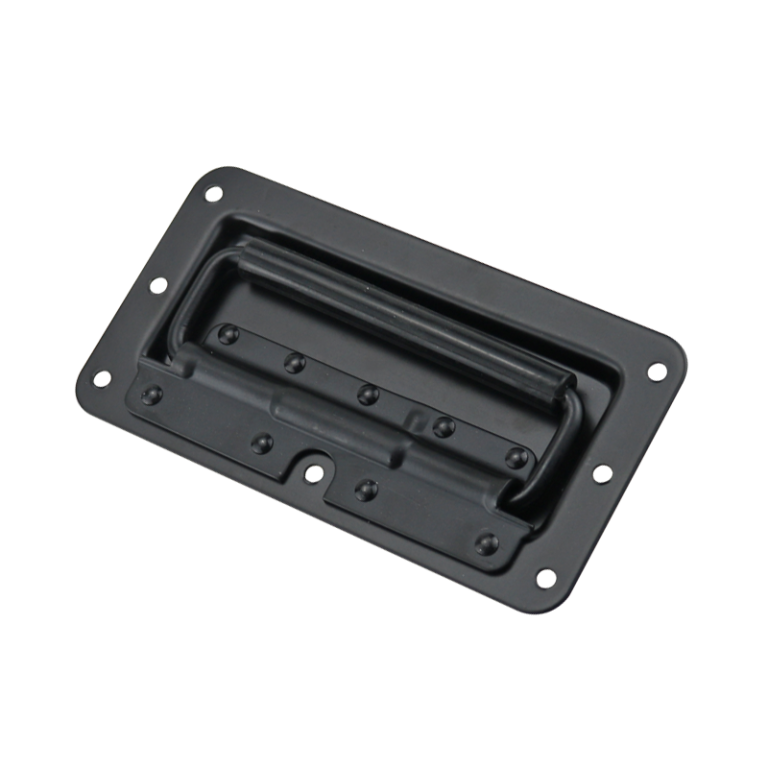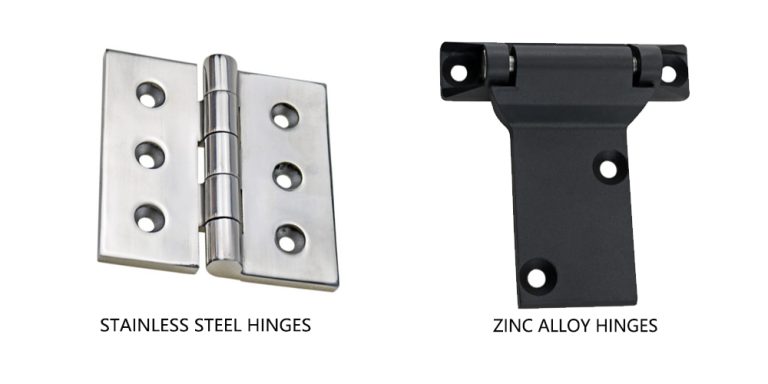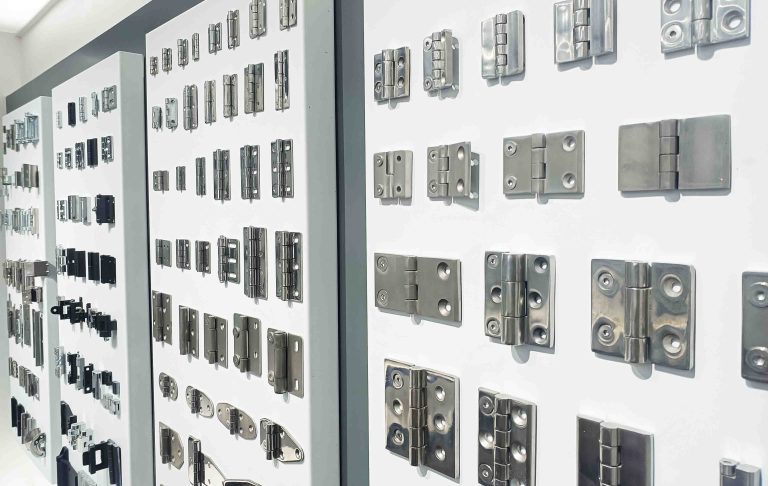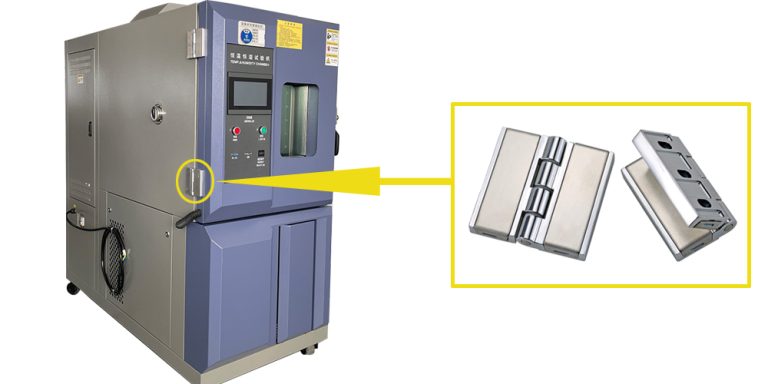HTAN is one of the leading manufacturers of industrial hinges, handles and latches in China.
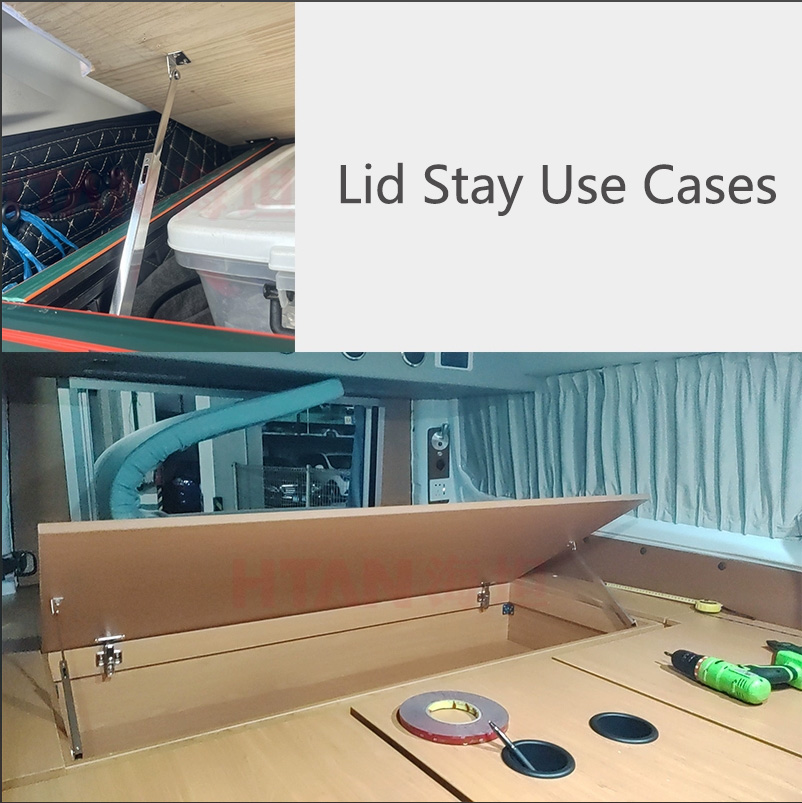
Application of Lid Stay on Cover Plate
The lid stay is a common mechanical support device designed to provide stable lifting support for all types of lids and door panels. It allows users to easily lift heavy objects with one hand, either through internal pressure or a spring-loaded structure, and automatically maintains a fixed position once opened.
Whether it’s the hood of a car, the door of a furniture cabinet, or the access port of an industrial facility, the lid stay is like an “invisible assistant”. Imagine opening the front hood of your car and not having to lift it to keep it in place – that’s its core value.
Lid Stay Assembly
A complete set of lid stay typically consists of four key components:
1. The Rod
- A metal outer tube, filled with gas or fitted with a spring, is the main source of support.
- Higher-end products will have a rust-resistant coating for longer life.
2. Support Spring/Pneumatic System
- Hydraulic models work on nitrogen pressure.
- Spring models rely on metal elasticity, which determines their load-bearing capacity and speed of response.
3. Mounting Block
- Metal connectors at both ends, equipped with screw holes or snap designs, ensure that the stay can be firmly fixed to the equipment.
4. Anti-friction Sleeve/Seal
- Protects internal components from dust, especially critical in industrial environments.

Application of Lid Stay on Cabinets
Advantages of the Lid Stay
Stability
Precise force calculations ensure that the lid does not wobble when opened.
Test data shows that high quality hydraulic stay can maintain stable performance in environments from -30°C to 80°C.
Load-bearing Capacity
From 5kg for household cabinets to 50kg for truck hoods, different models cover the full range of scenario needs. When choosing, you need to reserve 20% of the load capacity.
Convenience of Operation
The design of “one lift and stop” significantly improves efficiency.
After using the hydraulic spreader, automobile mechanics can reduce the time to open and close the hood by 70%.
Durability
After 100,000 times of opening and closing test of industrial grade spreader bar, the service life can reach more than 10 years.
The surface treatment process directly affects the corrosion resistance.

Application of Lid Stay on Cover Plate
Introduction to Lid Stay Types
Hydraulic Stay
- Working Principle: Utilizing a combination of closed nitrogen pressure and oil fluid cushioning system.
- Advantages:
- Smoother lifting and lowering process
- Precise control of the opening and closing angle
- Suitable for high-frequency use scenarios
- Typical Applications: Automobile trunks, heavy equipment access doors.
Spring Stay
- How it Works: Support is provided by the compression/rebound of a metal spring.
- Advantage Comparison:
- 30%-50% lower cost
- Simpler structure and easier maintenance
- Applicable Scenarios: Household closet, office cabinet and other light load environments.
Hinged Stay
- Structural Features: Combine the support mechanism and hinge into one.
- Innovative Design:
- Saves installation space
- Supports multi-angle hovering
- Common Use: Laptop screen holder, console flip cover.

Free-Stop Lid Stay
Working Principle of Lid Stay
Four Steps to Installation
- Measure the weight and opening angle of the cover.
- Select the corresponding specifications of the cover stay.
- Fasten the two ends of the mounting base with screws (pay attention to keep parallel).
- Test the opening and closing smoothness and fine-tune the position.
Mechanical Balancing Mechanism
- Example (Hydraulic Type):
When an external force is applied to open the lid, the internal piston compresses nitrogen gas to store energy; when it reaches the specified position, the air pressure and the weight of the lid plate reach equilibrium, realizing automatic locking.
Eight Application Scenarios of Lid Stay
Automobile Field:
Hood, trunk, truck cargo doors… Modern vehicles use an average of 4-6 sets of stay.
Intelligent Furniture:
Lift beds, invisible lockers and other innovative designs rely on customized stay solutions.
Industrial Equipment:
Cleaning lids for food processing machines and safety doors for injection molding machines require explosion-proof stay.
Electronics:
Server cabinets and 5G base station maintenance ports prioritize high temperature resistant models.
Medical Equipment:
CT scanner covers use medical grade stainless steel stay to ensure radiation shielding.
Agricultural Machinery:
Combine harvester access panels are equipped with dustproof and waterproof struts to adapt to the field operating environment.
Aerospace:
Titanium alloy lightweight struts are used in aircraft baggage hatches, reducing weight by up to 40%.
Smart Home:
Automatic lifting TV cabinet, hidden projection screen can not be separated from the miniature electric spreader bar.
Application of Lid Stay on Cabinets
Method for Selecting a Lid Stay
Scene Matching Principle
Kitchen cabinets → choose moisture-proof type spring spreader bar
Garage door → with high load-bearing hydraulic models
Outdoor equipment → recognize the IP65 protection level
Load Bearing Formula
Required force = (cover weight × opening angle coefficient) ÷ 2
(Note: It is recommended to consult an engineer for precise parameters)
Dimensional Measurements
Contracted length: determines the minimum installation space
Extension length: affects the maximum opening angle
Stroke difference: hydraulic type need to reserve 5-10mm buffer
Brand Quality Identification
Check ISO 9001 certification
Test rebound uniformity
Check the surface treatment process
FAQ
Q1: How long does the lid stay last?
Household spring stay: 3-5 years / 20,000 times
Industrial hydraulic spreader bar: 8-10 years/100,000 times
(Regular cleaning of the slide can extend the life by 30%)
Q2: How to replace the damaged stay bar by myself?
Operating Instructions:
Temporarily fix the cover with a rope
Remove the screws at both ends of the old stay
Compare the size parameters of the old and new parts
Install in parallel and test the load capacity
Q3: Do I need regular maintenance?
Maintenance Recommendation:
Check seals quarterly
Lubricate joints annually
Avoid strong acid and alkali environments
Q4: What can I do about the wobbling of the stay bar?
Troubleshooting:
Check if the mount is loose
Test for air pressure leakage
Confirm whether the weight of the cover is over the limit
Conclusion
Lid stay in modern industrial use play an irreplaceable role in enhancing safety and convenience. From the closet door that opens and closes every day to the equipment hatch that keeps the production line running, the proper selection and maintenance of stay not only extends the life of the equipment, but also creates an efficient and comfortable experience.
When choosing a lid stay, remember: the right one is the best one.
Understand your specific needs and combine it with professional advice, and this seemingly simple device will become a secret weapon to enhance your product’s competitiveness.


